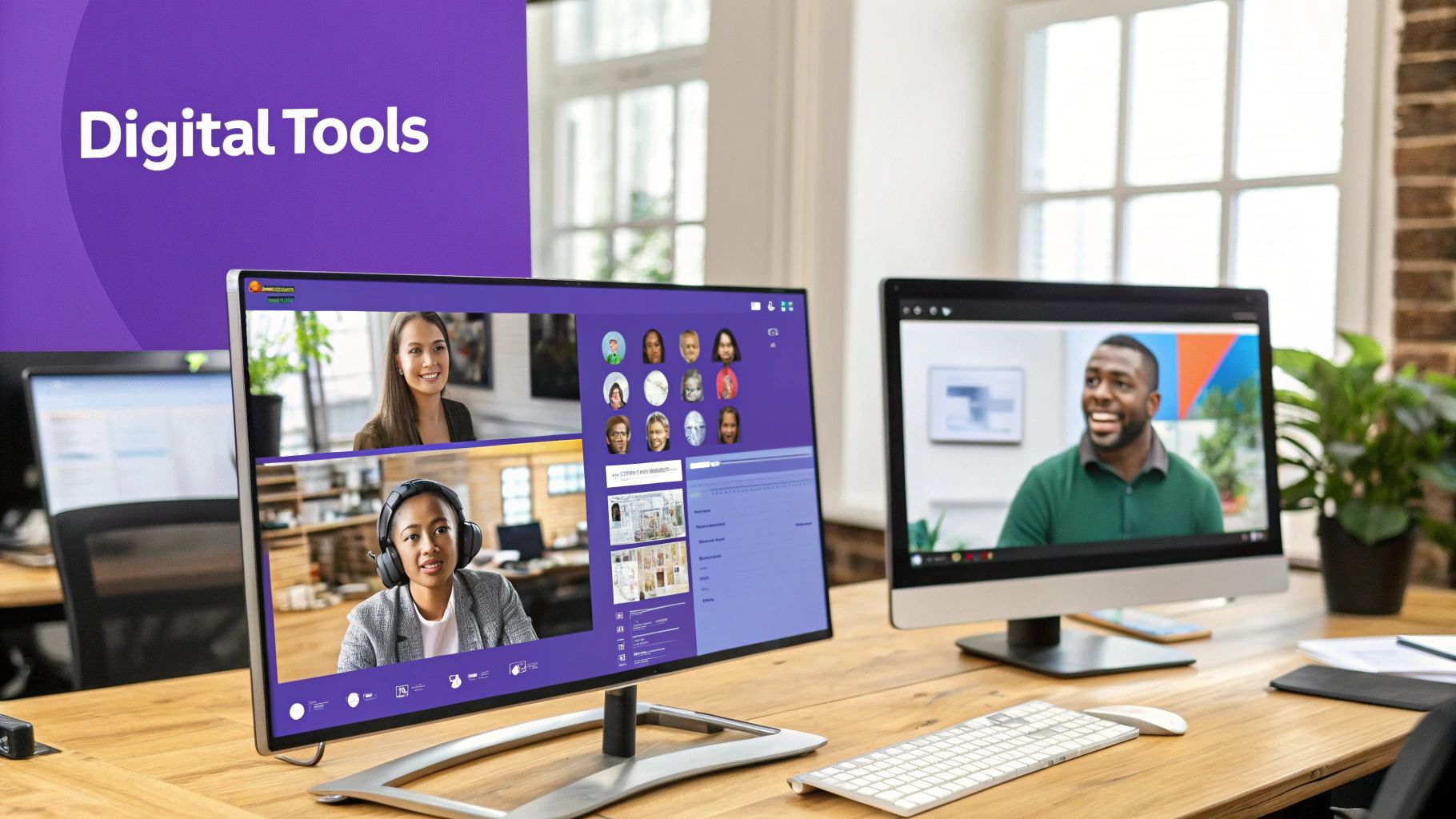The Evolution of Asynchronous Remote Work

Not long ago, remote work was a rare perk. Today, asynchronous remote work is not just common, but often the preferred way to work. This shift represents a fundamental change in how we collaborate and get things done. It's not just about location; it's about rethinking work itself.
From Experiment to Mainstream
Initially, many viewed asynchronous remote work with skepticism. Managers worried about productivity and team cohesion. However, the COVID-19 pandemic forced a rapid adoption of remote work, proving that distributed teams could thrive. This experience also revealed the benefits of asynchronous collaboration.
Asynchronous work allows team members across time zones to contribute effectively. This flexibility creates a more inclusive environment. It also promotes deep work by minimizing distractions. This shift has been supported by technology and changing attitudes about work-life balance. The adoption of tools like Slack and Microsoft Teams has been key.
By 2024, about 40% of the global workforce engaged in remote work. This is a significant jump from the pre-pandemic level of around 15% in 2019. This growth has been fueled by asynchronous collaboration tools, enabling work across different times. For example, Slack now has over 12 million daily active users. Asynchronous models improve global collaboration and productivity. Find more statistics here: Remote Work Statistics. Learn more about asynchronous work here: How to master asynchronous work.
Reimagining Workflows and Communication
Asynchronous remote work demands a fresh look at workflows and communication. Organizations are adopting tools designed for this new way of working. This includes project management software for transparent task management and communication platforms for seamless information sharing. But it's more than just new tools.
It requires a shift in mindset, prioritizing flexibility and outcomes over being constantly present. Companies need clear communication guidelines, expectations for response times, and a culture of trust and autonomy. This evolution is ongoing, as companies continually refine their approaches to asynchronous work. This promotes flexibility and emphasizes results over constant connection.
The Digital Backbone of Asynchronous Success

Asynchronous remote work depends heavily on a solid digital foundation. It's not about having the newest tech, but about choosing and using the right tools to support this way of working. These tools become the bedrock for successful distributed teams.
Essential Tools for Asynchronous Collaboration
High-performing asynchronous teams use a mix of tools to stay connected and productive. These include platforms for several key areas:
-
Project Management: Tools like Asana, Trello, or Jira offer a central hub for managing tasks, tracking progress, and meeting deadlines. This creates transparency and accountability without constant meetings.
-
Communication: Platforms like Slack, Microsoft Teams, or Twist enable focused communication using channels and threads. This keeps discussions organized, allows for file sharing, and provides quick updates, reducing email clutter.
-
Documentation: Knowledge bases, wikis, or platforms like Notion serve as key information repositories. Team members can find answers independently, promoting self-sufficiency and reducing the need for synchronous meetings.
-
Video and Audio Messaging: Tools like Loom or Voxer provide a simple way to share quick updates, explain complex ideas, or give feedback asynchronously, replacing long emails or unnecessary meetings.
Choosing the Right Tech Stack
Choosing the right tools means carefully considering your team's specific needs. A software development team might need a robust project management tool with advanced features like sprint planning and bug tracking. A marketing team, however, might find a simple Kanban board is all they need.
A one-size-fits-all approach doesn't work. It's about finding the best combination that supports efficient workflows, improves communication, and streamlines processes. The market for remote work tools is growing rapidly. The remote workplace services market is expected to reach $111.63 billion by 2030, with a 23.9% CAGR. This highlights the increasing demand for tools that support asynchronous work, like video conferencing and project management platforms. Zoom, for example, saw significant growth, with a 335% increase in daily meeting participants during the pandemic. These tools are essential for communication and collaboration in asynchronous remote settings. Learn more: Remote Work Statistics.
Integrating Tools for Seamless Workflows
Just having the tools isn't enough. Successful asynchronous teams integrate these platforms into smooth, connected workflows. This might involve automating tasks, linking tools through integrations, or creating clear guidelines for how each tool should be used. A team could automate notifications from their project management tool to their communication channel, keeping everyone updated on tasks in real-time.
To help illustrate the range of available tools, let's look at a comparison:
Top Asynchronous Collaboration Tools by Category
A comparison of leading tools that support different aspects of asynchronous remote work
| Tool Category | Popular Solutions | Key Features | Best For |
|---|---|---|---|
| Project Management | Asana, Trello, Jira | Task management, progress tracking, deadline management | Teams needing structured workflows and task visibility |
| Communication | Slack, Microsoft Teams, Twist | Channels, threads, file sharing, direct messaging | Teams needing organized, real-time communication |
| Documentation | Notion, Confluence, Google Workspace | Knowledge bases, wikis, collaborative document editing | Teams needing a central source of information |
| Video & Audio Messaging | Loom, Voxer | Quick video and audio message recording and sharing | Teams needing efficient, asynchronous feedback and updates |
This table provides a snapshot of some popular options, but it's important to research and choose the tools that best suit your team's specific requirements.
The goal is to build a digital environment that empowers team members to work effectively, collaboratively, and independently, no matter where or when they work. This is how you build a successful asynchronous remote work environment.
Crafting Communication That Transcends Time Zones

Effective communication is the cornerstone of successful asynchronous remote work. It's not just about sending emails or instant messages. It's about building a communication framework that fosters clarity, minimizes misunderstandings, and respects individual boundaries across different time zones.
Establishing Clear Communication Channels
Asynchronous remote teams need clearly defined communication channels. Think of it like a well-organized city with clear road signs. This means establishing guidelines for which channel to use for different types of communication.
For example, urgent requests might go through a dedicated Slack channel, while project updates could be posted in a project management tool like Asana or Trello. Consider creating a central communication hub, perhaps a team wiki or intranet, to house important documents and announcements.
Setting Realistic Response Expectations
In asynchronous work, immediate responses aren't always feasible. Instead of expecting constant availability, establish clear expectations for response times. This could mean agreeing on a 24-hour response window for non-urgent inquiries.
This reduces anxiety and allows team members to focus on deep work without the pressure of constant notifications. It also means defining what constitutes an "urgent" request to avoid unnecessary interruptions.
Documentation: The Heart of Asynchronous Knowledge Sharing
Documentation is even more critical in asynchronous remote work. It's how teams share knowledge and context, acting as the team's collective memory, accessible to everyone regardless of location or schedule. However, documentation shouldn't be overwhelming.
- Prioritize clarity and conciseness: Keep documents focused and easy to understand.
- Use visuals: Diagrams, flowcharts, and videos can communicate complex information more efficiently than text.
- Establish a regular review process: Ensure documentation stays current and relevant.
This helps prevent information overload and ensures the information is readily digestible. You might be interested in: How to master remote collaboration strategies.
Mastering Written Communication
When you can't quickly clarify something in person, clear written communication becomes paramount. In asynchronous remote work, well-structured writing is essential. This means:
- Using clear subject lines: This allows team members to quickly prioritize messages.
- Providing context: Explain the background and purpose of your message.
- Using bullet points and formatting: This makes information easier to scan and understand.
- Proofreading carefully: Misunderstandings are more likely to occur in written communication, so accuracy is key.
This proactive approach to writing avoids confusion and ensures everyone stays informed.
Communication Protocols: Balancing Thoroughness and Sanity
Finally, establish clear communication protocols. Balance the need for thorough information sharing with avoiding unnecessary meetings and communication overload. This could mean implementing daily or weekly status updates via a shared document or using a project management tool to track progress and communicate changes.
This structured approach keeps everyone informed while respecting individual time. Asynchronous remote work thrives on clear communication that empowers teams to collaborate effectively while maintaining a healthy work-life balance.
Beyond Hours Logged: Measuring What Actually Matters

Traditional productivity metrics, like hours spent at a desk, are no longer relevant in the world of asynchronous remote work. This work model prioritizes flexibility and output. It requires a new approach to measuring what truly matters: results. This shift changes how we think about and define productivity.
Embracing Results-Based Systems
Leading distributed organizations recognize that asynchronous remote work necessitates a results-oriented approach. These organizations focus on the quality and impact of the work produced, rather than tracking time spent online. This involves setting clear goals, establishing transparent processes, and cultivating a culture of accountability.
For example, instead of checking employee login and logout times, managers might monitor progress on project milestones or the completion of key deliverables. This approach empowers employees to manage their own time and work in a way that best suits them.
To understand the key differences in productivity measurement, let's look at the following comparison:
Synchronous vs. Asynchronous Productivity Metrics
How productivity measurement differs between traditional and asynchronous work environments
| Aspect | Traditional Approach | Asynchronous Approach | Benefits of Asynchronous Method |
|---|---|---|---|
| Focus | Time spent working (e.g., hours logged) | Output and results achieved | Emphasizes actual value delivered |
| Measurement | Attendance records, timesheets | Project milestones, deliverables completed | More accurate reflection of productivity |
| Management Style | Often more prescriptive and supervisory | Focus on goals and autonomy | Empowers employees and fosters trust |
| Flexibility | Limited, often requiring fixed work hours | High, allowing individuals to adjust their schedules | Improved work-life balance and potentially increased output |
| Communication | Primarily synchronous (e.g., meetings) | Primarily asynchronous (e.g., email, project management tools) | Reduces interruptions and allows for deep work |
This table highlights the shift from tracking input (time spent) to measuring output (results achieved). The asynchronous approach offers benefits like increased flexibility and a stronger emphasis on the value delivered.
Goal Setting: Clarity Without Micromanagement
Effective goal setting is paramount for asynchronous remote work. Goals should be SMART: Specific, Measurable, Achievable, Relevant, and Time-bound. This framework provides clarity and direction without constant supervision.
Involving team members in the goal-setting process is crucial. This encourages buy-in and ensures everyone is on the same page. When team members understand the objectives and how their contributions fit into the larger picture, engagement and productivity naturally increase.
Progress Tracking: Visibility Without Surveillance
Tracking progress asynchronously requires a balance of visibility and autonomy. Using project management tools like Asana can help create transparent workflows and track progress toward shared goals. This offers visibility without constant oversight.
Regular progress updates shared through asynchronous channels keep everyone informed and minimize the need for frequent synchronous meetings. This promotes accountability and enables teams to identify and address potential roadblocks early.
Performance Evaluation Reimagined
Performance evaluations in asynchronous remote settings should center on outcomes and contributions, not perceived activity levels. Evaluate employees based on their ability to meet objectives, the quality of their work, and their overall impact.
This approach acknowledges that productivity is not about constant online presence but about delivering results. It promotes a culture of trust and empowers employees to manage their time effectively. This also reinforces the focus on results, rewarding those who deliver.
Building Accountability in a Trust-Based Environment
Asynchronous remote work relies on trust and autonomy. However, accountability is essential. Establishing clear expectations, providing regular feedback, and celebrating successes fosters a culture of responsibility.
This can be achieved through regular check-ins focused on progress and challenges, rather than simply monitoring activity. Open communication and transparent processes contribute to a sense of shared responsibility and ownership. Building this culture of accountability ensures high performance while maintaining the flexibility that is fundamental to asynchronous remote work. It empowers individuals to take ownership and contribute meaningfully.
Building Inclusive Cultures Across Time and Space
Asynchronous remote work offers exciting new ways to build truly inclusive workplaces. It allows companies to break free from traditional office structures and create environments where diverse individuals can thrive. This means understanding and accommodating different needs, preferences, and working styles so that everyone feels valued and can contribute effectively.
Leveling the Playing Field Through Documentation
Asynchronous communication depends heavily on documentation. When done well, this documentation creates a level playing field for everyone on the team. Well-maintained documentation ensures equal access to information, regardless of location or individual schedules.
For example, detailed records of project decisions, meeting notes, and established processes allow team members in different time zones to stay in the loop and contribute meaningfully, even if they can't attend live meetings. This encourages transparency and allows individuals to work more independently. This also empowers team members to contribute effectively, no matter where they are or what their time zone is.
Recognizing Diverse Contributions in Advancement Pathways
Traditional career advancement often favors those who are highly visible in meetings and other synchronous settings. However, in asynchronous remote work, contributions can take many different forms. It's important to recognize and reward diverse contributions, whether they come through detailed documentation, insightful asynchronous feedback, or consistently delivering high-quality work.
This might mean rethinking traditional performance reviews and focusing on tangible results rather than just visibility. Create clear advancement pathways that acknowledge different ways of adding value within an asynchronous framework. This approach allows people to advance based on merit and impact, regardless of their communication style or time zone.
Fostering Belonging Without Forced Camaraderie
Building connections in a distributed team requires a thoughtful approach. While social interaction is valuable, avoid forcing camaraderie or a culture of constant online presence. Instead, focus on creating opportunities for genuine interaction that respect individual preferences and boundaries.
This could involve setting up optional virtual coffee chats, groups based on shared interests, or asynchronous team-building activities. Publicly acknowledging and celebrating achievements is another way to foster a sense of shared accomplishment and recognition across the entire team.
Celebrating Achievements and Maintaining Cultural Cohesion
Maintaining a strong company culture in an asynchronous remote setting takes deliberate effort. Regularly celebrate team and individual accomplishments to reinforce a shared sense of purpose and success. This recognition can happen through public acknowledgements, company-wide announcements, or even small gestures of appreciation.
Building an inclusive culture means creating a sense of belonging without requiring constant online interaction. Encourage open communication and feedback, while also establishing clear expectations for availability and response times. This ensures everyone feels respected and valued, contributing to a positive and productive work environment. This is essential for creating a cohesive and supportive team.
Conquering the Real Challenges of Asynchronous Remote Work
Asynchronous remote work offers incredible flexibility and productivity. However, it also presents unique challenges. This section explores common obstacles and provides practical strategies for overcoming them, allowing your team to thrive in this popular work model.
Communication Delays and Misunderstandings
One of the biggest hurdles in asynchronous remote work is communication. Delays can derail projects, and misinterpretations can lead to frustration and errors. This is especially true for teams working across different time zones.
-
Establish clear communication protocols: Define which channels to use for different types of communication. Urgent issues might require a direct message or a dedicated Slack channel, while routine updates can be shared via email or a project management tool.
-
Set expectations for response times: Agree on reasonable response windows. A 24-hour response time for non-urgent inquiries can be more realistic than expecting immediate replies. This also allows for focused work without constant interruptions.
-
Prioritize clarity in written communication: Use clear subject lines, provide context, and structure messages logically with bullet points and headings. Double-check your writing for clarity and tone.
-
Encourage diverse communication methods: Supplement text with video or audio messages when appropriate to convey tone and nuance. This can add a personal touch and improve team cohesion.
Isolation and Maintaining Motivation
Working remotely can sometimes lead to feelings of isolation and decreased motivation. The lack of regular face-to-face interaction can impact team cohesion and morale.
-
Foster a sense of community: Create opportunities for virtual social interaction, such as online coffee breaks, team-building activities, or virtual co-working sessions.
-
Recognize and celebrate achievements: Publicly acknowledge successes and celebrate milestones to maintain motivation and recognize contributions.
-
Encourage open communication: Create a safe space for team members to share their challenges and concerns. This can help address potential issues early on.
-
Promote work-life balance: Encourage team members to set clear boundaries between work and personal time to prevent burnout. Learn more in our article about How to master leading remote teams.
Blurred Boundaries and Burnout
The flexibility of asynchronous remote work can blur the lines between work and personal life, potentially leading to overwork and burnout.
-
Encourage time blocking and scheduling: Help team members structure their days and allocate specific times for different tasks.
-
Promote productivity techniques: Encourage strategies like the Pomodoro Technique to maintain focus and take regular breaks.
-
Model healthy work habits: Leaders should set a positive example by prioritizing their well-being and demonstrating healthy work practices.
-
Provide resources for stress management: Offer access to resources like mindfulness apps or stress management workshops.
Maintaining Accountability and Visibility
In an asynchronous environment, maintaining visibility into team members’ work and ensuring accountability can be challenging.
-
Establish clear goals and expectations: Define specific, measurable, achievable, relevant, and time-bound (SMART) goals.
-
Use project management tools effectively: Utilize platforms like Asana, Trello, or Monday.com to track progress and manage deadlines.
-
Implement regular progress reporting: Establish a system for reporting progress updates, whether through daily or weekly reports or regular check-ins.
By addressing these challenges, you can create a thriving asynchronous remote work environment that empowers your team.
Ready to improve your remote team's brainstorming? Check out Bulby, the AI-powered brainstorming tool.

